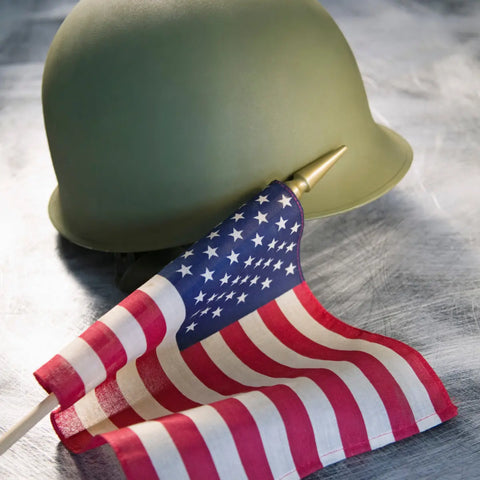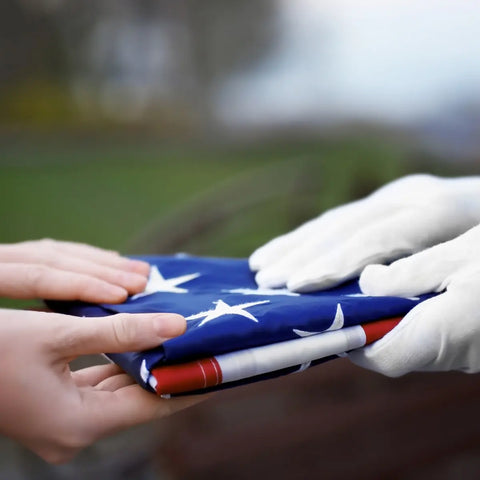From the early days of the Republic, the American flag has stood as a beacon of freedom and a symbol of the enduring spirit of its people. In the context of the military, this emblem carries an even deeper significance. It is not merely a piece of fabric but a profound representation of the nation's ideals, sacrifices, and aspirations. The history of the American flag customs in the military have evolved, yet the core values of honor, courage, and commitment that it embodies have remained steadfast. This flag has flown over countless battles, signifying not just the country's presence but its promise to protect and persevere. The stories of its presence on battlefields, within the ranks of those who serve, and at the heart of military ceremonies, weave a rich tapestry of tradition and valor that continues to inspire.

American Flag Traditions in the Military
Ceremony and Salute
In the heart of military tradition lies a deep respect for the American flag, manifested through meticulously observed ceremonies and salutes. Every gesture and movement is imbued with meaning, from the precise folds of the flag during retirement ceremonies to the respectful salutes it commands daily. These rituals, steeped in history, serve as a constant reminder of the sacrifices made for the nation. For instance, the flag-raising ceremonies held at dawn across military installations worldwide symbolize a new day of service and commitment, while the lowering at dusk honors those who have served and sacrificed. This cycle of reverence emphasizes the patriotic symbols in military operations, emphasizing the flag's role as a cornerstone of military identity and pride.
The Flag in Deployment
For service members deployed overseas, the American flag represents a tangible connection to the home they've vowed to defend. Displayed on uniforms, equipment, and bases, it serves as a daily reminder of their mission and the values they fight for. This practice of displaying the American flag in military contexts highlights its significance as a symbol of national unity and resolve. It's a piece of home that accompanies soldiers, sailors, airmen, and Marines to the far corners of the globe, offering comfort amidst uncertainty and danger.
Battle Honors
Throughout history, the American flag in war has been more than a standard borne into battle; it has been a rallying point. Stories of the flag being carried at the forefront of pivotal battles, often in the hands of a designated flag bearer, highlight its role in galvanizing troops and embodying the cause for which they fight. The flag’s presence in combat symbolizes the unity and resolve of the force, offering a visual focal point that transcends the chaos of battle.
The Final Salute
One of the most poignant uses of the American flag in military traditions occurs during funerals, where it is draped over the coffins of fallen service members as a final salute to their sacrifice. This tradition, rich in symbolism and respect, signifies the nation's gratitude and remembrance of the deceased's service. The carefully choreographed folding and presentation of the flag to the next of kin is a powerful act of honor. This solemn tradition highlights how the American flag is honored on battlefields and in peacetime, serving as a lasting tribute to those who have given their all in service to their country.
The Symbolism of the American Flag in Armed Conflicts
Beyond Colors
On the battlefield, the American flag transcends its physical form of stars and stripes, embodying the very essence of freedom, resilience, and justice that the nation stands for. Its presence during conflicts serves as a powerful reminder of the ideals and liberties that service members commit to protect. This emblem of unity and strength inspires a sense of duty and purpose, reinforcing the resolve of those who serve under it. It is not just a banner; it is a symbol of the enduring spirit of a nation united in its pursuit of peace and democracy. The flag's role in armed conflicts highlights the profound connection between the nation's values and the sacrifices made to uphold them, ensuring that the principles it represents are never far from mind, even in the most challenging circumstances.
Historical Conflict
As we trace the flag's journey through various historical conflicts, we see not only the evolution of its design but also the deepening of its significance. Each war has left an indelible mark on the fabric of the nation, and the flag has borne witness to these changes, embodying the spirit of resilience and unity that defines the United States. Here's how the flag has journeyed through these conflicts:
- Revolutionary War (1775-1783): During the Revolutionary War, the American flag's initial designs united the Thirteen Colonies in their fight against British dominion, symbolizing their shared quest for independence. The flag, in its infancy, was a powerful emblem of unity and resistance, flying high over battlefields, fortresses, and diplomatic assemblies. It was a visual declaration of a new, united identity, standing against oppression and championing the right to self-governance.
- Civil War (1861-1865): In the tumult of the Civil War, the American flag took on new meanings, representing the Union's commitment to preserving the nation and ending slavery. As the nation was torn in two, the flag became a beacon of hope for unity and freedom, carried into battle by Union soldiers as a symbol of the principles they fought to uphold. The survival of the flag as the symbol of a single, undivided nation underscored the victory of unity over division and freedom over oppression.
- World War I (1914-1918): With American involvement in World War I, the flag was thrust onto the global stage, symbolizing the United States' pledge to support peace and democracy worldwide. As American soldiers fought alongside allies on foreign soil, the flag embodied the nation's ideals and commitment to a just world order. It marked the emergence of the United States as a significant global power, dedicated to the defense of democratic values and the pursuit of international peace.
- World War II (1939-1945): Throughout World War II, the flag served as a rallying symbol for the Allied forces, embodying the fight against fascism and totalitarianism. It stood as a beacon of hope and resilience in the darkest times, waving over military bases, ships, and foreign battlefields. The flag's presence underscored the United States' role in the global struggle for freedom and the establishment of a post-war world order based on democratic principles and human rights.
- Vietnam War (1955-1975): The flag's role during the Vietnam War reflected the era's complexities and divisions, representing the sacrifices and service of the military even as the nation grappled with internal dissent. It became a symbol of both patriotism and protest, highlighting the contentious nature of the war and the deep social and political divisions it exposed.
- War on Terror (2001-Present): In the ongoing War on Terror, the American flag symbolizes resilience, perseverance, and the enduring fight against extremism. It flies over military bases, government buildings, and public spaces as a reminder of the threats the nation faces and the collective resolve to overcome them. The flag embodies the spirit of unity and strength in the face of adversity, reflecting the nation's commitment to protecting its values and securing a peaceful future.
The American flag's journey through these wars illustrates its role not just as a national emblem, but as a participant in the unfolding story of the United States. It stands as a testament to the nation's enduring ideals of freedom, democracy, and unity, through times of conflict and peace.

Symbols Within Symbols
The tradition of unit flags, deeply ingrained in military culture, serves as a visual representation of the pride and esprit de corps unique to each military unit. These flags are not just pieces of fabric but are imbued with the stories, achievements, and sacrifices of the men and women who have served within their ranks. When displayed alongside the American flag during parades, ceremonies, and other official events, they offer a poignant reminder of the multifaceted nature of military service, reflecting the specialization of each unit within the cohesive force of the nation's defense apparatus.
In addition to their symbolic importance, unit flags also serve practical purposes in the field, aiding in the identification and coordination of units during complex operations. Their presence during military engagements, exercises, and ceremonies is a testament to their enduring significance, weaving together the individual and collective narratives of courage and duty.
Protocols for Displaying the American Flag in Military Contexts
The Flag Code
The United States Flag Code establishes a framework of respect and dignity for displaying the American flag, a set of guidelines that hold profound significance within the military. These protocols ensure that the flag's presentation always reflects the nation's values, whether it flies atop a base or adorns a vessel. The Flag Code addresses various scenarios, prescribing how the flag should be displayed to other flags, how it should be raised and lowered, and the proper way to fold it. Adherence to these rules within military installations and operations is paramount. This codified respect reinforces the flag's role as a sacred emblem of the nation's ideals, entrusted to the care of those who serve.
The Importance of Proper Disposal
From the moment it is hoisted, to the point where it is deemed unfit for display due to wear or damage, every step in the flag's journey is imbued with deep significance. This process of disposal is more than just a practical measure; it is a ritual that pays tribute to the flag's enduring representation of the nation's ideals, history, and sacrifices. Here's a detailed look at the steps involved in this venerable tradition:
- Collecting Worn Flags: When an American flag becomes too damaged or worn to serve as a fitting emblem of the nation, it must be retired with dignity. Such flags are collected at designated drop-off points, which can be found at military bases, veterans' organizations, and sometimes at local government offices or scouting groups. This initial step ensures that the flag continues to be treated with respect even in its final days.
- Ceremonial Burning: The act of retiring a flag through ceremonial burning is deeply rooted in tradition and respect. The flag is carefully folded into its iconic triangle shape, symbolizing the tri-corner hats worn by Revolutionary War soldiers, which adds a layer of historical reverence to the ceremony. This folded flag is then solemnly placed into a fire, a process often witnessed by members of the community, veterans, and uniformed service members who gather to pay their respects. The ceremony might include a moment of silence, a final salute, or the playing of Taps, transforming the event into a powerful expression of national solidarity and gratitude.
- Reciting the Pledge of Allegiance or Offering a Final Salute: As the flames consume the fabric, those assembled may recite the Pledge of Allegiance or offer a final salute to the flag. This act serves as a poignant farewell, acknowledging the flag's role in symbolizing the freedoms and principles upon which the country was founded. It is a moment of reflection on the sacrifices made by countless individuals to uphold these ideals, offering a gesture of farewell that mirrors the gratitude and reverence felt by those in attendance.
- Burying the Ashes: The culmination of the flag's journey is the careful collection and burial of its ashes. This step ensures that the flag's remains are accorded the same dignity in death as it was in life, laid to rest in a dignified location where it can symbolize the cycle of service and sacrifice coming to a respectful end. This final act of burial signifies a physical and symbolic return to the earth, closing the chapter of the flag's service with honor and solemnity.
The process of retiring an American flag through these steps is a powerful ritual that reaffirms the nation's commitment to its core values and history. It serves as a reminder of the weight of responsibility that comes with the freedoms the flag represents, ensuring that even in its final moments, the flag continues to inspire and command respect.
Acquiring and Honoring the American Flag
Where to Buy American Flags Online
For those looking to purchase an American flag, authenticity and quality are paramount. Several reputable sources ensure that the flags meet the strict standards expected of this national symbol. U.S. flag store locations, both physical and online, specialize in flags that adhere to official specifications, offering a range of sizes and materials suitable for various display needs.
Similarly, American flag store websites provide convenient access to high-quality flags, with detailed product descriptions and care instructions to help buyers make informed decisions. These retailers often support American manufacturers, further underscoring the flag's domestic significance. When planning to buy American flag options, considering these dedicated sources guarantees that the flag represents the nation's ideals in material and craftsmanship.

The Flag at Home
Whether flown on national holidays, significant anniversaries, or every day, the flag symbolizes a personal connection to the country's values and history. As mentioned previously, proper display protocols, such as positioning the flag prominently and ensuring it is in pristine condition, reflect the respect and reverence owed to this emblem. For many, the home display of the flag also serves as a tribute to family members who have served or are serving in the military, making it a tangible link to personal stories of sacrifice and service.
The American flag will undoubtedly continue to play a central role in military service, adapting to new challenges while remaining an enduring symbol of national identity and pride. As the armed forces evolve, so too will the traditions and protocols surrounding the flag, ensuring that it remains relevant and revered across all branches of service. Innovations in warfare, changes in societal values, and advancements in technology will influence how the flag is displayed and honored, but its core symbolism will persist. The flag will continue to inspire service members, veterans, and citizens alike, serving as a unifying emblem of the nation's past, present, and future aspirations. As the military marches forward, the flag remains a constant, guiding light, embodying the spirit of America and its unwavering commitment to uphold the freedoms for which it stands.




